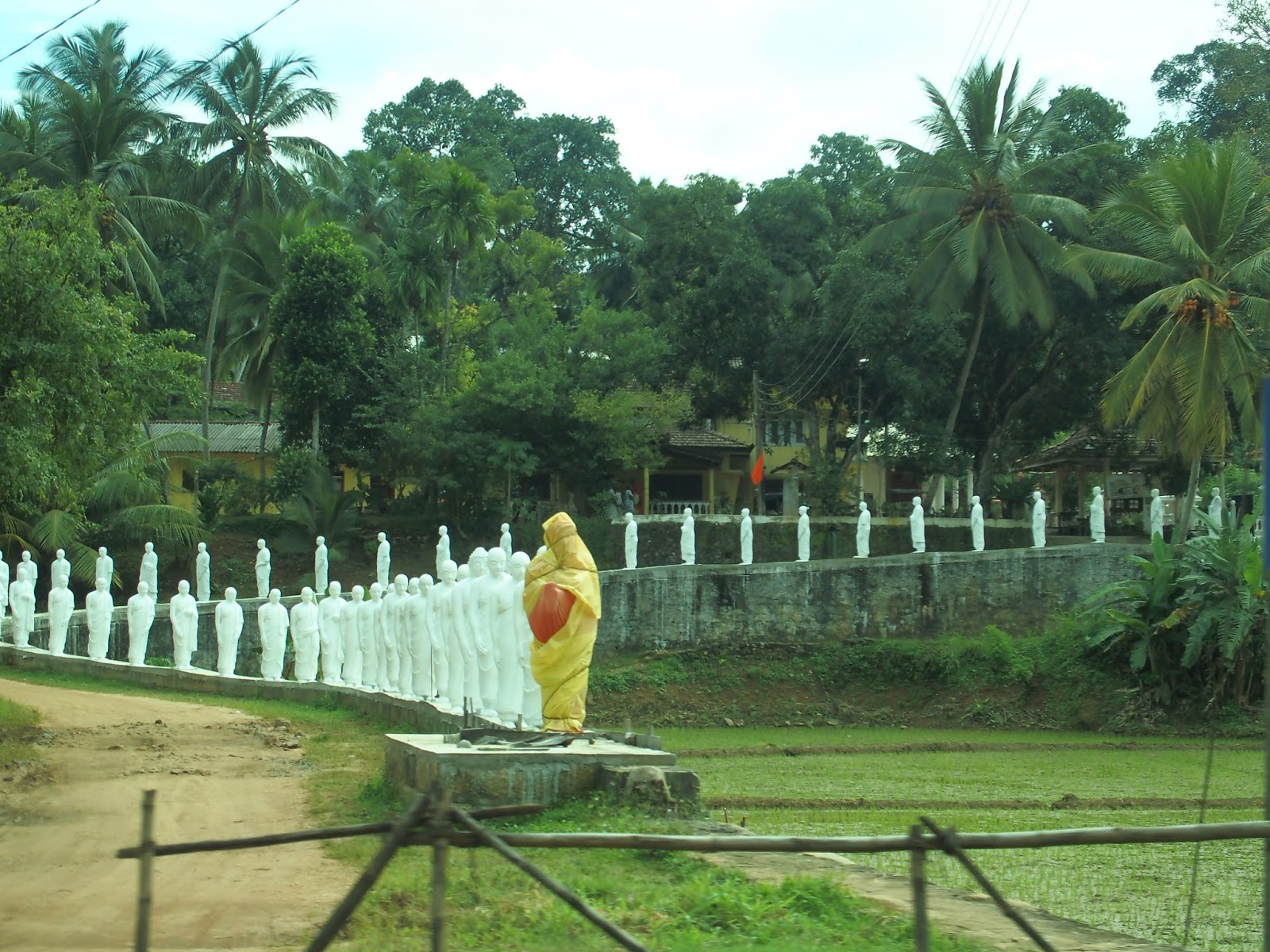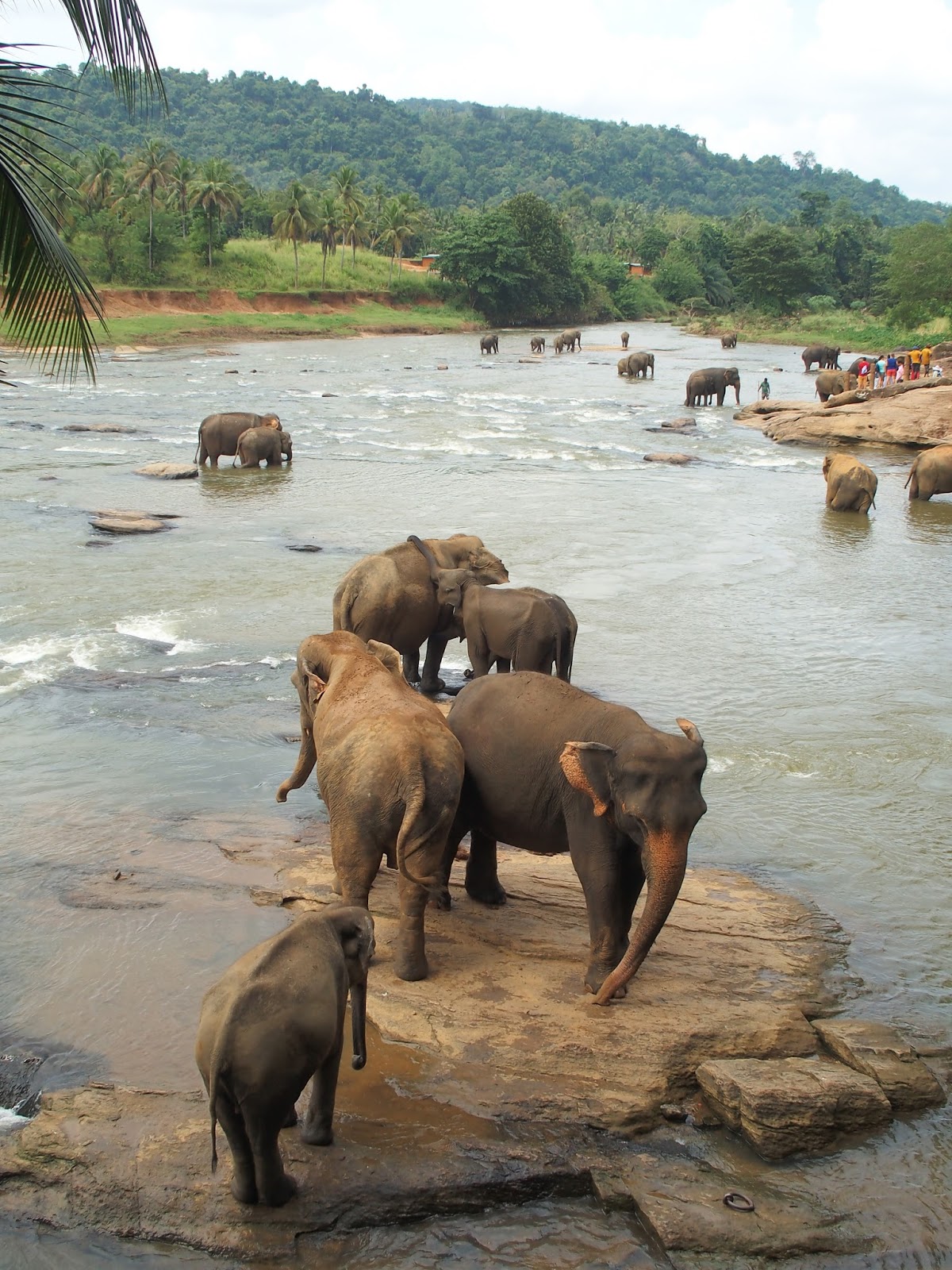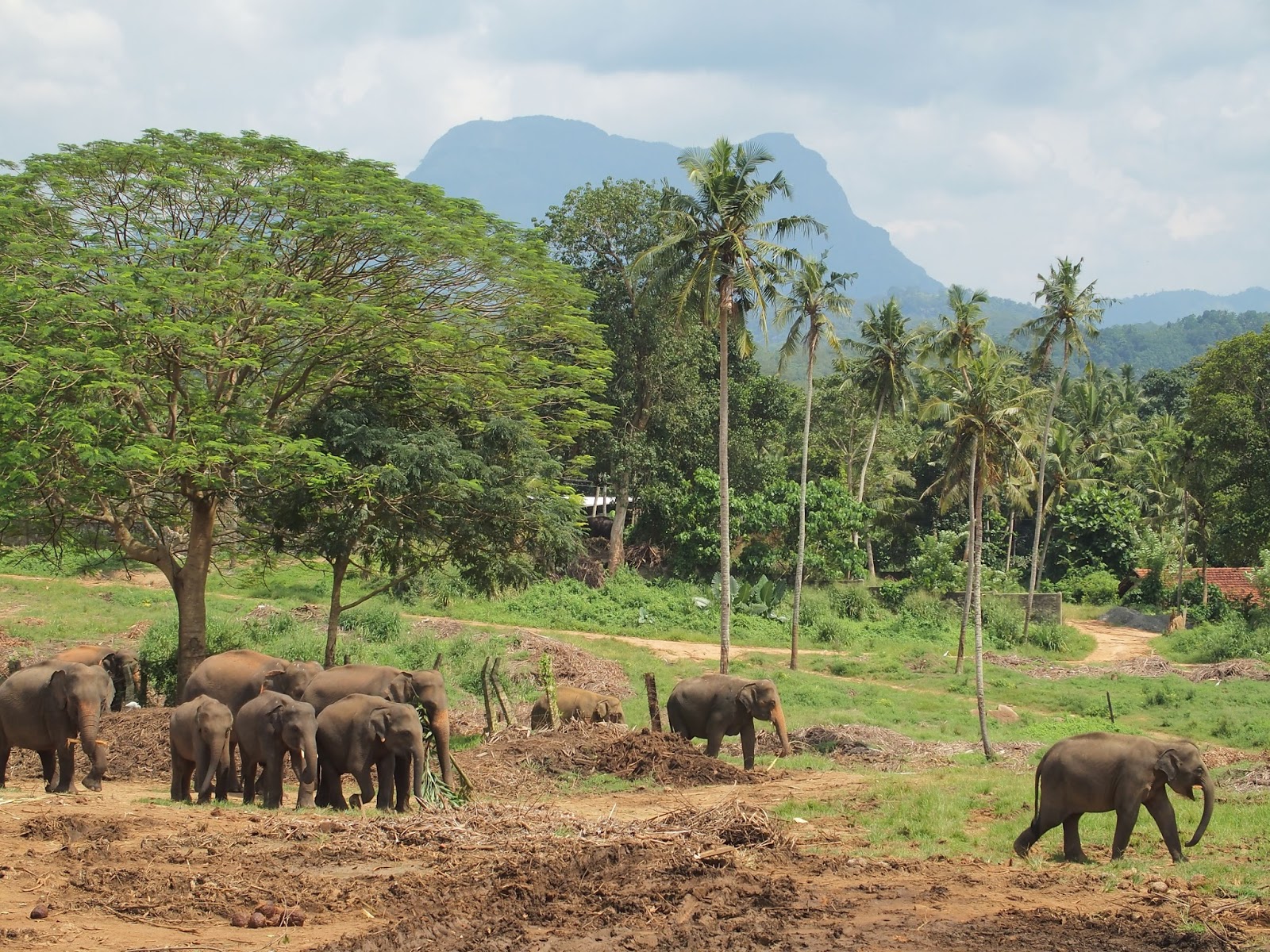It was a vibrant, colorful, riveting day in Sri Lanka. Today, Everything was out of the ordinary even for Sri Lankans, and so my attention was fixed upon it all. Today was different; there was no ignorance of that.
A normal day probably would have brought sights devoid of orange
flags. But the flags were everywhere. We drove and drove for two hours from
Colombo to Pinnawala, passing through different towns and beautiful countryside
upon which plantations of pineapple, rice, cocunut, and cashews grew. The orange followed us the whole
way. The color gave the already
colorful Sri Lanka a radiance I had not witnessed on my first visit earlier in
the year.
We arrived at 19:30 the night before this trip. Many of my fellow crewmembers and
friends were disappointed to learn that restaurants and bars were closing early
that night. Even worse, alcohol
was not being served (noooooooo!
I’m not much of a drinker, but some of us are!). This was due to the passing of Venerable
Madoluwawe Sobitha Thero, one of Sri Lanka’s great religious leaders. He had passed away only two days before
our ship docked in Colombo. We
were there to witness some of the aftermath.
Madoluwawe Sobitha Thero was a Buddhist monk, an esteemed
scholar and a seemingly tireless fighter for social and religious justice in
Sri Lanka. His work spanned over
six decades. Throughout the nation
people of every belief and disposition came out to mourn and to celebrate
Sobitha Thero’s life. His efforts
played a vital part for a major political shift in the country in January 2015.
On the grounds of Kotte Sri Naaga
Viharaya, where the funeral pyre was built, the recently-elected president of
Sri Lanka, Maithripala Sirisena, is quoted as having said, “With all my
strength, I pledge before the remains of Sobitha Thero that I will do
everything in my power to abolish the executive presidency.”
More info can be found here at http://www.news.lk/news/sri-lanka/item/10786-nation-bids-farewell-to-ven-maduluwawe-sobitha-thero. The language tends toward one-sidedness,
but balanced well with objectivity.
Plus, not many can argue about the good for which Sobitha Thero stood.
Former president Mahinda Rajapaksa is renowned for having
finally uprooted the Tamil Tigers after thirty years of bloodshed. Though his administration was the one
to end the civil war, there was a growing need for change in the country. Rajapaksa’s administration enjoyed (and
still enjoys) popularity among many Sri Lankans. But allegations of major corruption, power lust, and human
rights violations during and after the war plagued the president. Thousands have also “disappeared,” as
Rajapaksa used intimidation and even brutality to undermine opposition. Thus the need for change grew, and President
Sirisena was elected in the “Rainbow Revolution” of January 2015.
The gripping story of how this major change in politics came
about can be found here:
And, overall, Sobitha Thero’s ideals have majorly influenced
the minds of both the politicians and the people.
I wondered about this monk for the entire trip. I had no Wi-Fi connection, so I couldn’t research anything until I got back to the ship. Our guide was a modest, to-the-point man, and he only gave short answers to my questions. Plus, he was busy talking about our destination anyway! But the orange flags continued to appear moment by moment on our long road to Pinnawala. Moment by moment my curiosity grew.
So, getting back to my day in Sri Lanka: after all that having
being said, on this day good thoughts, harmony, celebratory mourning, and happiness
permeated the heavy, moist air.
For a country that has had a cease to major fighting only since 2009,
contentment seemed to dominate.
The good for which Sobitha Thero fought far outweighed the troubles of
the past. The “Rainbow Revolution”
definitely has some of his strength imbued in it.
Our van continued to pass by many different things, finally leaving Colombo altogether.
Our van continued to pass by many different things, finally leaving Colombo altogether.
There were ten of us, all eager to see the Pinnawala
Elephant Orphanage. Our ride was a
van. Our guide was a good-natured
man who gave succinct answers and summary-like info. I watched many vehicles rushing past us. We drove down bustling motorways, past
grimy, decrepit buildings and newer buildings alike. The sidewalks were scattered with people. At times, pedestrians went for it;
tuk-tuks and cars immediately stopped.
Vehicles past each other all the time, making sure oncoming traffic was
at least a few seconds away….
Power lines whizzed by.
Some buildings were missing roofs. Roadside stands and shops were
swarthy and sweaty, topped with sheet metal or wood or tarps or cloth. It was all a pretty collage of the
lifestyles Sri Lankans lead. A
road would give way to rice fields, cocunut trees, ferns and semi-jungles. Pineapple stands lined the road for a
good ten minutes before giving way to another pretty-collage town. And then more wide fields, mountains
and hills, tall trees and foliage, all green and moist and teeming with
life.
…And we drove past more coconut plantations, more rice
fields, small shops and hotels and homes in the distance. Slowly, over the last half hour the landscape
gave way to rolling hills, mountains, and dense rubber tree plantations. I could sense full jungles nearby. We were almost at the orphanage.
The Pinnawala Elephant Orphanage is arguably the largest of
its kind in the world. Elephants
found alone and orphaned in the jungles are taken here to be cared for. Over eighty elephants now reside here. A breeding program for the elephants
was implemented in 1982, seven years after the foundation of the
orphanage. Today the community of
elephants has its own herds. Scholars
from around the world recognize the success of the orphanage.
Some concerns have been raised about the orphanage. Employees have been allowing more
“photo time” with adult elephants, thereby increasing the chances of making an elephant
uncomfortable around tourists…and therefore more dangerous given the
proximity. Other details about how
Pinnawala conducts itself can be found at this site:
I myself was allowed to walk up to an adult female and take
a picture. I politely refused,
wanting only to interact with it.
But it was only a minute or so before the mahout (the herder or handler) told me, “ok; go
back. …go back, sir.” He said it with a hint of alarm in his
voice. I looked back to the
elephant then, and she was moving and swaying a little…. I didn’t look her in the eyes, but I
took his word for it and moved from the muddy field back to the dirt
walkway. I assumed these men knew what they were talking about…. Any longer and I might have been
knocked around quite a bit! But at
least for a short time everything was secure.
Back at the river, things were different because the walkways
were raised.
Obviously we couldn’t go down to the
water, but it was great enough to feed bananas to them! I remember this one big male.

He was greedy, man! He was always sticking out his trunk into our line of walking, even putting it in the way of the baby elephant….
That kid needs to eat more than him!

He was greedy, man! He was always sticking out his trunk into our line of walking, even putting it in the way of the baby elephant….
That kid needs to eat more than him!
The way the muscles work at either end of the nose thrilled
me. Of course we know elephants
can grip at something with their trunks.
To see that up close as you are
feeding them is an experience.
You see the top and bottom
part of the nose contact and close a little over the nostrils like a nubby
claw. It was so different! I started imagining how evolution and the other natural
processes of things came to give this function (let alone the amazing thing
that is the trunk) to the elephant.
Did mammoths have this function, too? I still think about this today!
Feeding the elephants was just as fun, and fascinating, as
watching them in the field.
I
could have watched them for hours.
Having now done something like this for the first time in my life, I now
understand how and why scientists and researchers can watch animals in the wild
for so long. There’s a sense of invigoration in observing how other animals
interact with each other and their environment. There’s always
something to spot, something new to see. For instance, I saw this younger
elephant trying to tear up a piece of tree log; I thought she was just stepping
on it while meandering. But then
she looked down at it, held it in place, and started tearing at it with her
trunk. In essence, many
instances of their intelligence kept my senses fixated.
The whole scene of the field took my breath away. Without the elephants, the beauty of
the immediate scenery and of the mountain in the distance would be beautiful. With the elephants, the scenery becomes
almost out-of-place. A beautiful
landscape seems only simple. Like
you’ve seen it before. But it is
so…unrealistic…for a human being to
see a beautiful, simple landscape with many large, majestic animals like the
elephant roaming around. As if, to
begin with, this should not happen in
most places in the world. It
should not happen at all. Think about it. If you came across herd of elephants
this large, and this close, in the
wild, they would most likely charge you. You’d be dead! These elephants are captive, but
efforts to maintain their “wild’ mentality are prioritized. The Pinnawala orphanage has therefore created
something improbable: a place where one gets to interact with a large amount of
elephants in the most realistic “wild” setting that can be mustered. That is why this place has left such an impact
upon me.
This link leads to some great information about the history of
the Sri Lankan people and their interaction with elephants, from the religious
side of things to capturing and taming procedures to tourism. Some of the content will most likely be
hard to read for some animal lovers out there, but nonetheless I found this
link to be more than worthy of being called a good source for the topic at
hand.
We traveled a different road back to Colombo, a road full of
lush jungle, rolling fields of rice and cocunut and pineapple plantations, and
hills and mountains. The sky poured on us for half of the
journey. As tired as I was (waking
up early and spending the day out in hot, soupy weather will do that to you) I
didn’t want to miss any of it.
When one travels to Sri Lanka, or for that matter Thailand,
Vietnam, or Indonesia, an initial shock might be felt. Most of the buildings and homes are not
as “clean” or “proper” as in the west: homes made with metal sheet roofs,
crumbling buildings, peeling paint and plaster, rusty public transportation…are
everywhere. In some large cities
there are Western-style buildings, but they are somewhat far-removed from the
reality of it all. The people of
Sri Lanka live a very different life from that of the West. And it is hot and muggy. None of it is bad, though. There’s a certain “colorful” quality to
it all. The color is imparted by
sheer difference. But the people are no different from you and
I. People are content, or
discontent but doing their best. People are resilient.
Sri Lanka now has a great new avenue to travel. Politically things are different, and
as of six years ago, the country has known peace. Sure, there are still traces of the bad times lingering, but
nothing stays the same forever. I,
as a traveler, will always be humbled by such a place that is far removed from
what I know in Southern California.
As different as Sri Lanka is for me, I did not know Sri Lankans were
also feeling differences in their own lives. Only since January has the country’s politics changed
drastically. I feel even more
humbled to have witnessed evidence of this change in addition to everything
else the country has to offer. Indeed,
Sri Lanka means “sacred beauty.” That,
at least, has not changed.
A few blogs from now, I will talk about a similar experience in
Thailand that happened about a week later. It, also, involved animals, more farmland, rolling
landscapes, and hot weather. The
differences? The animals were
Bengali tigers, and not elephants (just keep ‘em coming; what an opportunity!); I was able to people watch and interact with
very friendly and humble people (and others who didn’t hesitate to take
advantage of me); the heat was more dry than humid (which meant that my energy
level was enhanced); I was able to see the influence of WWII on Thailand (an
unexpected but powerful stop on the way to the Tiger Temple); and an overall
more immersive experience in the Thai culture (seeing as how we had three days
there, whereas in Sri Lanka we had only one full day). These differences were nothing but
good, shining with brilliant color.
My humility grew and grew.
Afterthoughs: More On
Politics And Religion In Sri Lanka
Even though Sobitha Thero was a fighter for justice, there
has been darker news regarding hard-line Buddhists in Sri Lanka in recent
years. Sobitha Thero is not to be
compared or coupled with this different group. If you recall, two years ago a Sri Lankan Buddhist monk set
himself on fire. Sri Lankan
officials blasted the media’s coverage of the suicide. Hard-line Buddhists hailed the man as a
hero for Buddhist ideals, but moderate Buddhists also sided with the monk.
In Sri Lanka, some of the hard-line Buddhists are being
accused of stirring up racial and social unrest, especially against the Muslim
community. The Sri Lankan hard-liners
are a group called Bodu Bala Sena, and it was supported by the Rajapaksa
administration. The full article
is here: http://www.bbc.com/news/magazine-32929855
It is disconcerting and unfortunate to see a religion—one
that arguably boasts the strongest sentiments for non-violence—that today has
hard-line followers making news stories.
These stories have been troubling for me. For over a year I have been delving into several of the
Dalai Lama’s books, absorbing his views and teachings. Then, when the recent news from Myanmar
started coming out, I tried to fit all that counter-intuitive knowledge with
the Dalai Lama’s…. It felt insane,
like trying to mix the oil of hard-line Burmese and Sri Lankan monks with the
water of monks like the Dalai Lama.
But, I finally ran across this article written by Alan
Stathern, of Oxford University, who puts it into perspective fantastically: “…however
any religion starts out, sooner or later it enters into a Faustian pact with
state power. Buddhist monks looked
to kings, the ultimate wielders of violence, for the support, patronage and
order that only they could provide.
Kings looked to monks to provide the popular legitimacy that only such a
high moral vision can confer.
The result can seem ironic. If you have a strong sense of the overriding moral superiority of your worldview, then the need to protect and advance it can seem the most important duty of all.
The result can seem ironic. If you have a strong sense of the overriding moral superiority of your worldview, then the need to protect and advance it can seem the most important duty of all.
Christian crusaders, Islamist militants, or the leaders of
“freedom-loving nations,” all justify what they see as necessary violence in
the name of a higher good.
Buddhist rulers and monks have been no exception.”
His full article can be found right here: http://www.bbc.com/news/magazine-22356306
Disclaimer:
I do not intend to speak on behalf of Azamara Club Cruises. As an employee of Azamara Club Cruises, I hereby state that all views and expressions of opinion I hold are solely my own, and do not reflect or represent the views, values, beliefs, opinions, or company policies of ether Azamara Club Cruises or Royal Caribbean Cruises Ltd.
Additionally I neither own nor claim any legal rights to the links provided in this post.
Additionally I neither own nor claim any legal rights to the links provided in this post.









































































No comments:
Post a Comment